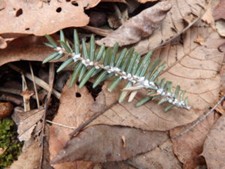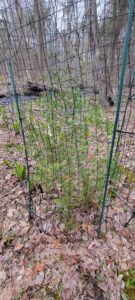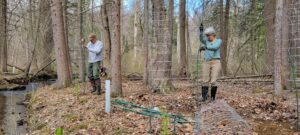According to the US Forest Service, “Due to the Eastern Hemlock (Tsuga canadensis) tree’s widespread distribution, long lifespan (in some cases they can live 800 to 1,000 years [Elias, 1980]), shade tolerance, ability to live in fairly acidic soil, hemlock plays a distinctive role in forest ecosystems.” Its unique ecological, recreational, and aesthetic qualities make this native conifer a highly valued component of forests in the Eastern United States.” Of particular importance, is that it is a foundation species, which means it creates the ecosystem in which it resides. In fact, hemlocks are the base of the food web and when grouped together as a stand they create unique soil and water conditions in the forest. One main niche hemlocks fill is in forested riparian areas where it is essential for the regulation of microclimates including soil conditions and especially stream temperature that are hydrologically more stable than streams in hardwood forests, making them more likely to support trout and aquatic insect species. In short, this native evergreen basically provides year-long shade to cool down forest streams that is essential to maintain habitat for certain fish species such as NJ’s only native Salmonid and State Fish, the Brook Trout (Salvelinus fontinalis).
However, in the last 30+ years the Eastern hemlock forests Davis (1993, 2003) identified have been severely degraded by the introduction of hemlock woolly adelgid (Adelges tsugae). Hemlock woolly adelgid is an aphid-like insect from Asia that feeds exclusively on hemlock and was first documented in Virginia in the 1950s. It spread throughout the eastern US, first appearing in NJ in 1978, and has caused severe decline and mortality of Eastern hemlock (Evans 2004). Eastern hemlock trees of all sizes and ages are attacked, but large mature trees that are tightly packed across the landscape can be severely attacked (Smith-Fiola et al. 2004).
Unfortunately for the hemlock population at Merrill Creek Reservoir (MCR) the hemlock woolly adelgid has decimated these trees that make up a portion of the floodplain of the Merrill Creek, which has been designated by the NJDEP as a Wild Trout Stream – FW2-TPC1 water. This designation means this water body is considered as having exceptional water quality of ecological significance, as well as exceptional recreational significance, exceptional water supply significance, and/or exceptional fisheries resources (in the case of the Merrill Creek – its home to native Brook Trout).
With dying or dead hemlock trees not being able to cast shade on the creek and help regulate its water temperature for the trout, MCR, with assistance from the USFWS’ Partners in Fish and Wildlife Program, are now planting another NJ native conifer species to replace the hemlock. That native conifer species is the Atlantic White Cedar (Chamaecyparis thyoides) (AWC).
AWC although also in decline (but in decline for different reasons in NJ, mostly due to sea-level rise, over abundant white-tailed deer herbivory and lack of forest management), it is considered a globally rare plant community, and one of ecological and cultural significance. AWC not only provides shade to streams, but it also helps promote ground water rechange, as well as supports various wildlife life including the caterpillar of the rare Hessel’s hairstreak (Callophrys hesseli) feeds exclusively on Atlantic white-cedar, making this species of special concern dependent on healthy cedar forests to complete its life cycle. Additionally, the Black-Throated Green Warbler (Dendroica virens), another species of special concern, will also use these habitats almost exclusively for breeding in New Jersey. The long-lived, disturbance dependent AWC once occupied over 115,000 acres in NJ, particularly in the Pinelands region and extending into the Hackensack Meadowlands and Sandy Hook peninsula. However, AWC can still be found in a few small, isolated pockets in the northern part of the state, including parts of High Point State Park and Waywayanda State Park.
With assistance from the MCR Volunteer crew, the implementation of AWC planting has started at MCR with the focus on the long-term benefits that the AWC will bring as the trees grow to maturity.




